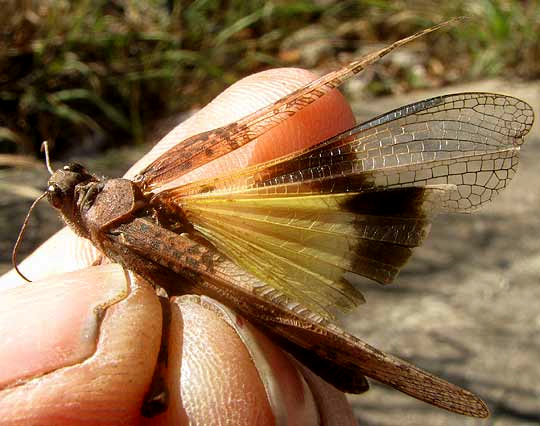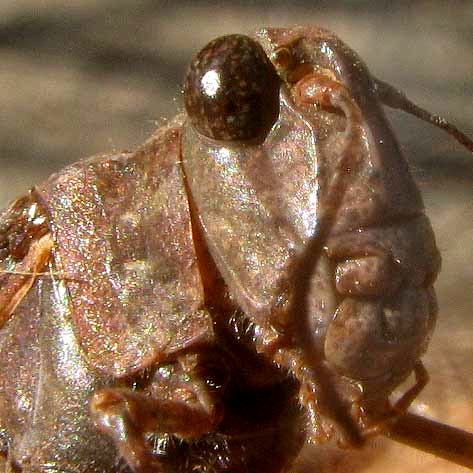Excerpts from Jim Conrad's
Naturalist Newsletter

from the November 17, 2013 Newsletter issued from the Frio Canyon Nature Education Center in the valley of the Dry Frio River in northern Uvalde County, southwestern Texas, on the southern border of the Edwards Plateau; elevation ~1750m (~5750 ft); N29.62°, W99.86°; USA
PALLID-WINGED GRASSHOPPER
There's a huge world of grasshoppers, and they can be hard to identify. For example, the other day after a night when it nearly frosted a smallish grasshopper turned up basking in early morning sunlight. Usually when I try to get close enough to a grasshopper for a close-up they jump, but this one didn't. I figured he'd gotten cold in the night and maybe was stunned. That's him above.
As that picture was snapped, the poor grasshopper fell over. He wasn't dead because his legs had been moving, so I figured maybe the night's cold had numbed him more than I'd thought. I further thought that with such an immobile grasshopper, maybe I could get a picture of the wing color, for that's often an important field mark. Picking up the critter and spreading his wings, I got the picture appearing below:

With such a cooperative subject, it was also easy to snap the fine face picture shown below:

It was clear that with such short antennae our friend was a member of the Short-horned Grasshopper Family, the Acrididae, and with the colored bands on the back wings he further belonged to the Band-winged Grasshopper Subfamily, the Oedipodinae. However, at that point identification gets sticky. Bea in Ontario and I thought it might be a Threebanded Grasshopper, genus Hadrotettix, but we were so uncertain that we uploaded the pictures to BugGuide.Net's ID forum, where eventually an expert let us know how wrong we were. We had the Pallid-winged Grasshopper, TRIMEROTROPIS PALLIDIPENNIS, commonly occurring from British Columbia, Canada south through the western half of the US, to Argentina in South America. Pallid-winged Grasshoppers are the most widely distributed band-winged grasshopper in the New World.
By the way, one feature that with my blurry vision I hadn't even noticed until he was on the laptop screen was that our grasshopper was missing his back jumping leg. No wonder he fell over!
Pallid-winged Grasshoppers eat many kinds of herbs, grasses and shrubs, especially in places where there's plenty of bare ground on which to bask and rest. Often they turn up in weedy city lots. Sometimes their numbers suddenly skyrocket, creating grasshopper plagues of biblical dimensions. In huge numbers they can defoliate nearly all wheat plants in a field, and nibble off their heads. They can consume a cotton field to ground level. They've invaded and damaged fields of safflower and grapes as well as cotton, sugarbeets, barley, and corn.
In April of 1998, in west-central Arizona, during the night swarms of Pallid-winged Grasshoppers were attracted to city lights, where street traffic crushed them, causing such a mess that cars and trucks skidded and slid. Accumulations of grasshoppers around buildings reached a depth of two inches (5cm).
You can read much more about this interesting grasshopper on their USDA page at https://www.sidney.ars.usda.gov/grasshopper/ID_Tools/F_Sheets/pallidwg.htm.